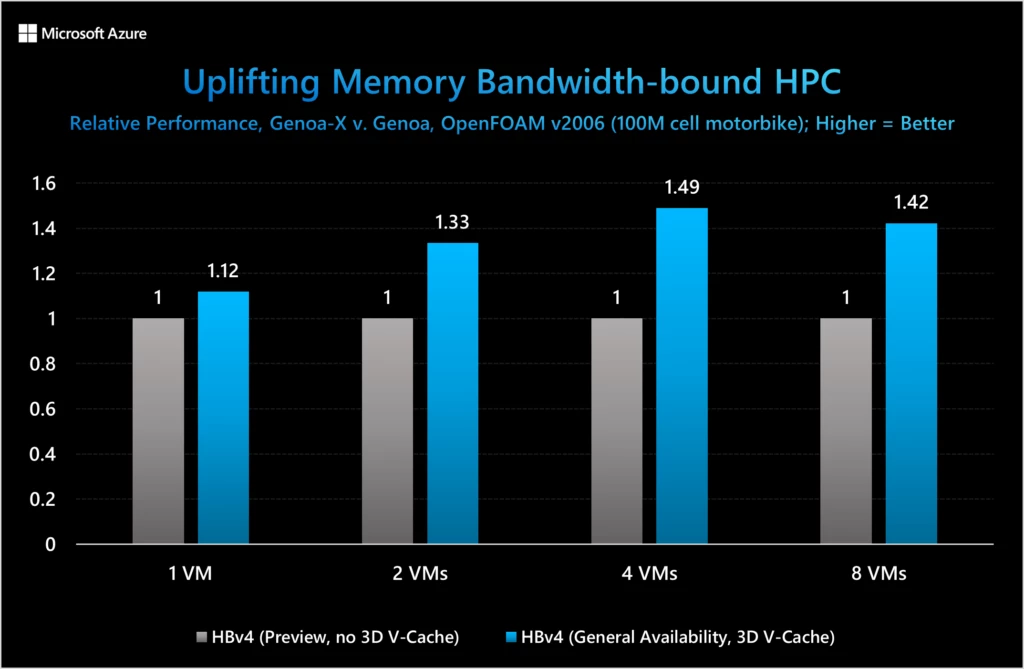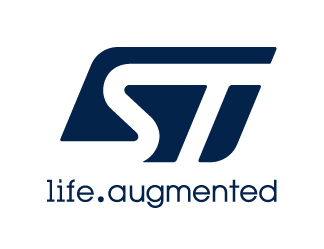We are excited to announce Azure HBv4 and HX-series Virtual Machines (VMs) are now generally available. With the general availability, Microsoft is offering customers the first VMs featuring the latest 4th Gen AMD EPYC™ processors with AMD 3D V-Cache™ technology (codename ‘Genoa-X’), paired with 400 Gigabit NVIDIA Quantum-2 InfiniBand. Azure HBv4 and HX-series VMs offer leadership levels of performance, scaling efficiency, and cost-effectiveness for a variety of HPC workloads such as computational fluid dynamics (CFD), financial services calculations, finite element analysis (FEA), geoscience simulations, weather simulation, rendering, quantum chemistry, and silicon design.
Compared to Azure HBv3-series VMs using 3rd Gen AMD EPYC™ processors (codename ‘Milan-X’), already the highest performance VMs for HPC workloads on the public cloud, customers will see up to:
- 1.6 times higher performance for rendering
- 2.4 times higher performance for weather simulation
- 2.7 times higher performance for CFD
- 4.2 times higher performance for molecular dynamics
- 5.7 times higher performance for structural analysis
Visit our technical blog for more detailed performance and scalability information and see below for a summary of performance across a diverse selection of widely used high performance computing (HPC) workloads.

Figure 1: Performance comparison summary of Azure HBv4/HX-series VMs to HBv3-series across diverse engineering and scientific computing workloads.
Azure HBv4 and HX-series VMs are available today in the Azure East United States region, and will soon come to the Azure Korea Central, South Central US, Sweden Central, and Southeast Asia regions.
Faster, more cost effective, and more power efficient technologies for HPC
Azure HBv4 and HX series VMs feature 4th Gen AMD EPYC™ processors with AMD 3D V-cache™ because they deliver the fastest levels of performance to a variety of memory performance-bound HPC workloads. The 2.3 GB L3 cache per VM can deliver up to 5.7 terabytes per second of bandwidth to amplify up to 780 gigabytes per second of bandwidth from main memory, for a market leading blended average of 1.2 terabytes per second of effective memory bandwidth across a broad range of customer workloads. For widely-used memory bandwidth-bound workloads like OpenFOAM, HBv4-series VMs with 4th Gen AMD EPYC CPUs with 3D V-Cache technology are already yielding up to 1.49 times higher performance than standard 4th Gen EPYC processors in Azure’s internal testing.

Figure 2: Performance comparison of HBv4/HX during Preview (no 3D V-Cache) versus General Availability (includes 3D V-Cache) from 1-8 VMs on CFD workload OpenFOAM.
Azure HBv4 and HX series VMs deliver these significant performance enhancements at lower cost and energy consumed per job directly proportional to the rate of workload speedup (such as 25 percent faster performance on a given HPC workload with AMD 3D V-Cache compared to standard 4th Gen AMD EPYC CPUs translates to the customer incurring 25 percent lower cost and power consumed per job).
Learn more about performance and scalability across a range of applications, models, and configurations, and visit Azure Docs for full technical specifications of HBv4 and HX series VMs.
Continuous improvement for even more HPC customers
Microsoft is delivering a new era of high-performance computing in the cloud; one defined by continuous improvements to the critical research and business workloads that matter most to our customers. Through our partnership with AMD, we’re making this vision a reality by raising the bar on the performance, scalability, and value we deliver with every release of Azure H-series family VMs for our HPC customers.
With the release of Azure HX series VMs, a new class within the Azure H-series family, we are extending our commitment to customers running large memory workloads like structural analysis and semiconductor design. The 1.4 terabytes of memory in every HX-series VM enables customers to run more of a data intensive workload out of memory for significant speedups and cost reductions. For widely used automotive simulators like MSC Nastran, Azure’s internal testing shows the new HX series VMs yield up to 5.7 times higher performance than HBv3-series VMs, and 9.2 times higher performance than HC-series VMs released 4 years ago featuring technology still widely utilized in on-premises HPC environments today.

Figure 3: Performance uplift from 2019–2023 on Azure H-series family Virtual Machines for structural analysis application MSC NASTRAN.
Customer Momentum
“Materials sciences researchers, including those working with Azure Quantum, stand to benefit greatly from the introduction of Azure HBv4 virtual machines featuring powerful new processors and networking technologies. The 4x performance increase on NAMD shows once again Microsoft’s commitment to continuously making the most advanced computing resources available through Azure cloud services.”—Nathan Baker, Senior Director, Partnerships for Chemistry and Materials, Azure Quantum.

“AMD EPYC™ processors, available through the Azure HB-series family of Virtual Machines via Ansys Cloud, have been instrumental in advancing our ability to deliver more CFD simulations in support of our Motorsports efforts in North America. We firmly believe that accelerating our simulation capabilities and the engineering insights gained from this work have been key to our recent string of successes in both IndyCar and IMSA prototypes. We are looking forward to evaluating the performance of Azure HBv4 and HX-series VMs powered by the 4th Generation of AMD EPYC™ processors with AMD 3D V-Cache™ technology in the very near future. We are confident that AMD and Azure will continue to deliver on their promise of sustainable performance to be realized in time-to and cost-of solution for our very complex CFD models with these processors.”—Kelvin Fu, Vice President at Honda Performance Development.

“With Azure high-performance computing, we can run more jobs and tasks in parallel. We reduce the time to market by increasing the efficiency and the quality of the product that we release. This solution helps us to improve the product quality and reduce the risk of a delivery delay.”—Anna Palo, Digital Design Architect, STMicroelectronics.

“The combination of Azure HPC and AMD (Advanced Micro Devices) processors offers enhanced performance with parallel processing, improve cost efficiency, flexible scalability, heterogeneous computing and energy efficiency alignment to PETRONAS’ sustainability initiatives, contributing to a greener computing environment.”—Muthu Kumar Sockalingam, Senior Manager at PETRONAS Digital.
